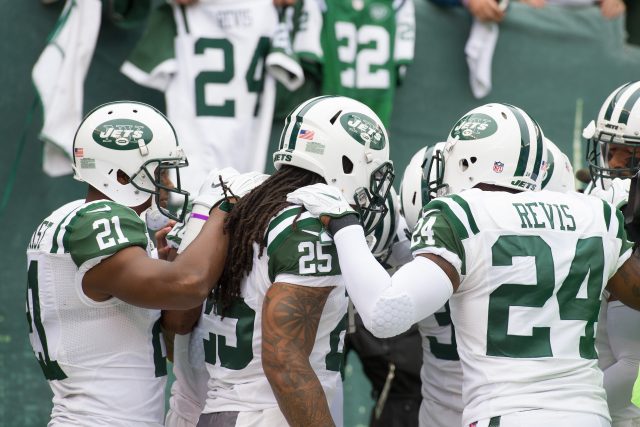ESNY Film Room: Breaking Down The New York Jets Horrid Pass Coverage


Too Much Respect For The Run Game; David Harris
The New York Jets currently rank 27th in the NFL in total pass defense, surrendering a robust 285 yards a game. While this stat alone screams volumes, it’s not the most disturbing factor about what’s transpired up to this point.
New York’s run defense is dominant, ranking second in the league (70.2 yards a game).
The reason for such a startling imbalance is strictly due to Todd Bowles’s stubborn defensive philosophies.
[sc name=”Jets Link Related” link=”elitesportsny.com/2016/10/01/new-york-jets-todd-bowles-must-move-away-ancient-defensive-principles/” text=”Jets’ Bowles Must Move Away From Ancient Defensive Principles” ]The Jets, no matter how light the offense lines up its personnel, continue to matchup with a bigger set.
For example, in Week 3 in Kansas City, Travis Kelce cut up the Jets to the tune of 89 yards and a score on six grabs. His lone touchdown came in the second quarter on this play:
The reason Kelce cut the Jets up was because Bowles remained persistent in making sure he could stop the run first. On this particular play, Andy Reid sent out a 3 WR, 1 TE, 1 RB personnel. Bowles matched with his nickel (4 DL, 2 LB, 5 DB). The problem with this is Kelce, K.C.’s TE, runs like a WR.
Matching up with the nickel means either Calvin Pryor, Darron Lee or David Harris will have to take Kelce one-on-one if it’s a man call. Obviously, it was man coverage here, and Pryor had zero chance of sticking with Kelce on the short crossing pattern.
The Chiefs currently rank 23rd in the league in rushing and were playing without Jamaal Charles. Why in the world would the Jets provide that much respect to the run game?
One week later against Seattle, Bowles, again, continued to remain stubborn in matching nickel against a speedy tight end in Jimmy Graham:
With the Jets leading 3-0 to begin the 2nd-quarter, Russell Wilson faced a 2nd-and-11 situation pinned deep. The Seahawks came out in the very familiar 3 WR, 1 TE, 1 RB situation. Instead of Bowles recognizing Graham needs to be treated like a WR, he allowed his heavier nickel defense to stay on the field.
This resulted in Russell identifying that Graham would beat rookie Darron Lee.
Why in the world, on a 2nd-and-11, would Bowles not go dime and throw Antonio Allen in the game in exchange for one of the linebackers? There is no big ground threat in this situation.
[sc name=”Jets Link Related” link=”elitesportsny.com/2016/10/03/new-york-jets-david-harris-no-longer-every-lb/” text=”David Harris Is No Longer An Every Down LB” ]What’s highly disturbing is that this isn’t a “once in a while thing.” Todd Bowles continues to run out his regular nickel personnel against any 3 WR set. While this might have worked in the 1980s, it doesn’t work in today’s league with tight ends running like wideouts.
If Bowles started playing a new-age style of defensive ball, he’d get David Harris off the field in favor of Antonio Allen and allow Pryor to sniff the box more alongside Darron Lee. Harris, as good a Jet as he’s been, is one of the worst covering LBs in the NFL.
Against Seattle, there were at least four glaring plays when Harris’s lack of coverage skills popped up. The most glaring came when C.J. Spiller abused him on the angle route for Seattle’s first TD of the game:
First off, Harris showed himself entirely too hard for the flat. He just couldn’t recover once Spiller turned it upfield.
More importantly, though, Harris wouldn’t have been put in this situation if Bowles appropriately matched up in a dime while treating Graham like a WR, not a TE.
[sc name=”Jets Link Slideshow” link=”elitesportsny.com/2016/10/08/breaking-new-york-jets-horrid-pass-coverage-game-tape/3/” text=”Out Of Position” ]Robby Sabo is a co-founder, CEO and credentialed New York Jets content creator for Jets X-Factor - Jet X, which includes Sabo's Sessions (in-depth film breakdowns) and Sabo with the Jets. Host: Underdog Jets Podcast with Wayne Chrebet and Sabo Radio. Member: Pro Football Writers of America. Coach: Port Jervis (NY) High School. Washed up strong safety and 400M runner. SEO: XL Media. Founder: Elite Sports NY - ESNY (Sold in 2020). SEO: XL Media.
Email: robby.sabo[at]jetsxfactor.com






